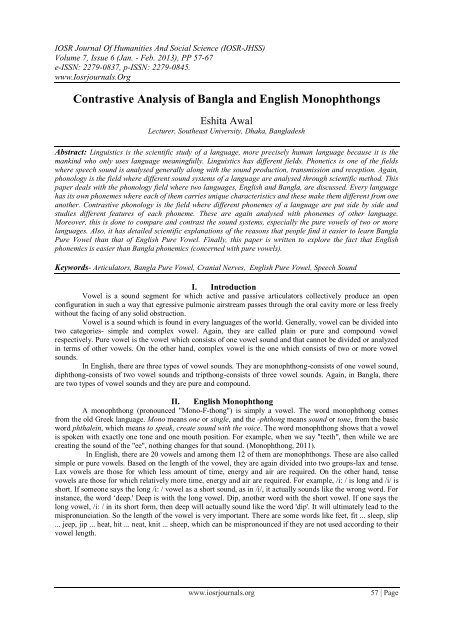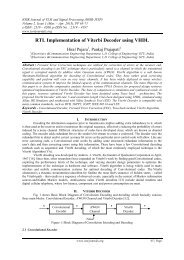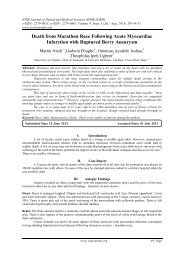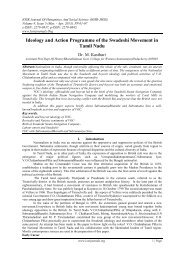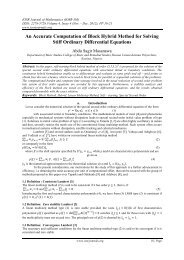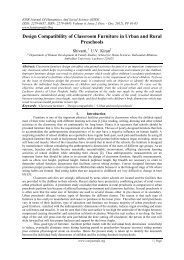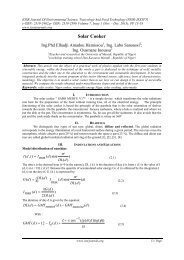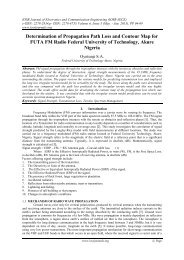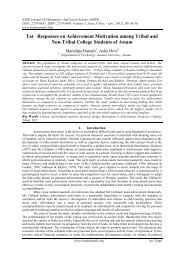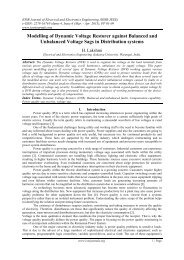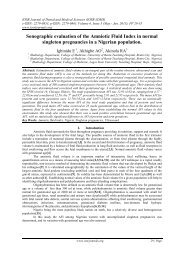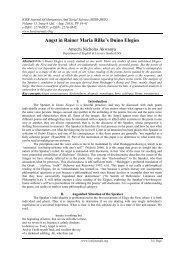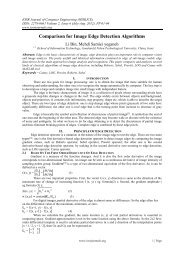Contrastive Analysis of Bangla and English Monophthongs - IOSR
Contrastive Analysis of Bangla and English Monophthongs - IOSR
Contrastive Analysis of Bangla and English Monophthongs - IOSR
You also want an ePaper? Increase the reach of your titles
YUMPU automatically turns print PDFs into web optimized ePapers that Google loves.
<strong>IOSR</strong> Journal Of Humanities And Social Science (<strong>IOSR</strong>-JHSS)<br />
Volume 7, Issue 6 (Jan. - Feb. 2013), PP 57-67<br />
e-ISSN: 2279-0837, p-ISSN: 2279-0845.<br />
www.Iosrjournals.Org<br />
<strong>Contrastive</strong> <strong>Analysis</strong> <strong>of</strong> <strong>Bangla</strong> <strong>and</strong> <strong>English</strong> <strong>Monophthongs</strong><br />
Eshita Awal<br />
Lecturer, Southeast University, Dhaka, <strong>Bangla</strong>desh<br />
Abstract: Linguistics is the scientific study <strong>of</strong> a language, more precisely human language because it is the<br />
mankind who only uses language meaningfully. Linguistics has different fields. Phonetics is one <strong>of</strong> the fields<br />
where speech sound is analysed generally along with the sound production, transmission <strong>and</strong> reception. Again,<br />
phonology is the field where different sound systems <strong>of</strong> a language are analysed through scientific method. This<br />
paper deals with the phonology field where two languages, <strong>English</strong> <strong>and</strong> <strong>Bangla</strong>, are discussed. Every language<br />
has its own phonemes where each <strong>of</strong> them carries unique characteristics <strong>and</strong> these make them different from one<br />
another. <strong>Contrastive</strong> phonology is the field where different phonemes <strong>of</strong> a language are put side by side <strong>and</strong><br />
studies different features <strong>of</strong> each phoneme. These are again analysed with phonemes <strong>of</strong> other language.<br />
Moreover, this is done to compare <strong>and</strong> contrast the sound systems, especially the pure vowels <strong>of</strong> two or more<br />
languages. Also, it has detailed scientific explanations <strong>of</strong> the reasons that people find it easier to learn <strong>Bangla</strong><br />
Pure Vowel than that <strong>of</strong> <strong>English</strong> Pure Vowel. Finally, this paper is written to explore the fact that <strong>English</strong><br />
phonemics is easier than <strong>Bangla</strong> phonemics (concerned with pure vowels).<br />
Keywords- Articulators, <strong>Bangla</strong> Pure Vowel, Cranial Nerves, <strong>English</strong> Pure Vowel, Speech Sound<br />
I. Introduction<br />
Vowel is a sound segment for which active <strong>and</strong> passive articulators collectively produce an open<br />
configuration in such a way that egressive pulmonic airstream passes through the oral cavity more or less freely<br />
without the facing <strong>of</strong> any solid obstruction.<br />
Vowel is a sound which is found in every languages <strong>of</strong> the world. Generally, vowel can be divided into<br />
two categories- simple <strong>and</strong> complex vowel. Again, they are called plain or pure <strong>and</strong> compound vowel<br />
respectively. Pure vowel is the vowel which consists <strong>of</strong> one vowel sound <strong>and</strong> that cannot be divided or analyzed<br />
in terms <strong>of</strong> other vowels. On the other h<strong>and</strong>, complex vowel is the one which consists <strong>of</strong> two or more vowel<br />
sounds.<br />
In <strong>English</strong>, there are three types <strong>of</strong> vowel sounds. They are monophthong-consists <strong>of</strong> one vowel sound,<br />
diphthong-consists <strong>of</strong> two vowel sounds <strong>and</strong> tripthong-consists <strong>of</strong> three vowel sounds. Again, in <strong>Bangla</strong>, there<br />
are two types <strong>of</strong> vowel sounds <strong>and</strong> they are pure <strong>and</strong> compound.<br />
II. <strong>English</strong> Monophthong<br />
A monophthong (pronounced "Mono-F-thong") is simply a vowel. The word monophthong comes<br />
from the old Greek language. Mono means one or single, <strong>and</strong> the -phthong means sound or tone, from the basic<br />
word phthalein, which means to speak, create sound with the voice. The word monophthong shows that a vowel<br />
is spoken with exactly one tone <strong>and</strong> one mouth position. For example, when we say "teeth", then while we are<br />
creating the sound <strong>of</strong> the "ee", nothing changes for that sound. (Monophthong, 2011).<br />
In <strong>English</strong>, there are 20 vowels <strong>and</strong> among them 12 <strong>of</strong> them are monophthongs. These are also called<br />
simple or pure vowels. Based on the length <strong>of</strong> the vowel, they are again divided into two groups-lax <strong>and</strong> tense.<br />
Lax vowels are those for which less amount <strong>of</strong> time, energy <strong>and</strong> air are required. On the other h<strong>and</strong>, tense<br />
vowels are those for which relatively more time, energy <strong>and</strong> air are required. For example, /i: / is long <strong>and</strong> /i/ is<br />
short. If someone says the long /i: / vowel as a short sound, as in /i/, it actually sounds like the wrong word. For<br />
instance, the word „deep.' Deep is with the long vowel. Dip, another word with the short vowel. If one says the<br />
long vowel, /i: / in its short form, then deep will actually sound like the word 'dip'. It will ultimately lead to the<br />
mispronunciation. So the length <strong>of</strong> the vowel is very important. There are some words like feet, fit ... sleep, slip<br />
... jeep, jip ... heat, hit ... neat, knit ... sheep, which can be mispronounced if they are not used according to their<br />
vowel length.<br />
www.iosrjournals.org 57 | Page
There are 7 lax <strong>and</strong> 5 tense vowels. The lax vowels are as following:<br />
/ɪ/ pit<br />
/e/ pet<br />
/æ/ pat<br />
/ɒ/ pot<br />
/ɒ/ luck<br />
/u/ good<br />
/ɒ/ ago<br />
<strong>Contrastive</strong> <strong>Analysis</strong> <strong>of</strong> <strong>Bangla</strong> <strong>and</strong> <strong>English</strong> <strong>Monophthongs</strong><br />
The features <strong>of</strong> closed, mid close, mid open <strong>and</strong> open are the different position <strong>of</strong> the tongue. When the tongue<br />
is maximally raised towards the alveolar ridge but it does not touch the alveolar ridge then that position is called<br />
closed position. In that position eggressive pulmonic airstream will face a great obstruction. When the tongue is<br />
raised <strong>and</strong> because <strong>of</strong> that air will face an obstruction, it is called mid close position. Similarly, when the tongue<br />
is little bit raised <strong>and</strong> maximally lowered we call it mid open <strong>and</strong> open position respectively.<br />
Figure: 1- Lax <strong>Monophthongs</strong> in diagram<br />
This is the diagram <strong>of</strong> the insight <strong>of</strong> the oral cavity. A represents the area <strong>of</strong> the upper teeth <strong>and</strong> alveolar ridge<br />
meeting point. B represents the area <strong>of</strong> the velum. C <strong>and</strong> D represent the area <strong>of</strong> the lower teeth <strong>and</strong> oropharynx<br />
respectively.<br />
The tense vowels are as follow:<br />
/iɒ/ meat<br />
/aɒ/ car<br />
/ɒ: / door<br />
girl<br />
/uɒ/ too<br />
www.iosrjournals.org 58 | Page
<strong>Contrastive</strong> <strong>Analysis</strong> <strong>of</strong> <strong>Bangla</strong> <strong>and</strong> <strong>English</strong> <strong>Monophthongs</strong><br />
Figure: 2- Tense <strong>Monophthongs</strong> in diagram<br />
From the above diagram the features <strong>of</strong> the pure vowels in <strong>English</strong> are described below:<br />
/I: /- during the articulation <strong>of</strong> /I: / the front <strong>of</strong> the tongue is raised towards the hard palate; almost in the close<br />
position. The lips are spread. This is why it is called front close vowel.<br />
/a: /- during the articulation <strong>of</strong> /a: /, the back <strong>of</strong> the tongue is in the complete open position <strong>and</strong> the lips are<br />
neutral. Thus this is called back open vowel.<br />
/ɒ: /- back <strong>of</strong> the tongue is raised towards the s<strong>of</strong>t palate during its articulation. The position is between the<br />
mid-open <strong>and</strong> mid-close <strong>and</strong> lips are rounded. Thus it is called back vowel between mid open <strong>and</strong> mid close.<br />
/u: /- this sound is articulated back <strong>of</strong> the tongue towards s<strong>of</strong>t palate <strong>and</strong> almost in the close position. The lips<br />
are closely rounded. It is called back close vowel.<br />
-during <strong>of</strong> its articulation the centre <strong>of</strong> the tongue is raised towards the ro<strong>of</strong> <strong>of</strong> the mouth <strong>and</strong> lips are<br />
spread. This is called central vowel between mid-close <strong>and</strong> mid-open.<br />
/I/-the front <strong>of</strong> the tongue is raised in the direction <strong>of</strong> the hard palate during its articulation <strong>and</strong> it is towards the<br />
position between the close <strong>and</strong> mid- close. The lips are loosely spread. Thus, this is called front vowel.<br />
/e/-the front part <strong>of</strong> the tongue is raised towards the hard palate in the position between mid-close <strong>and</strong> mid-open<br />
during its articulation. The lips are neutral in this case. That is why, it is called front vowel.<br />
/æ/-during its articulation the front part <strong>of</strong> the tongue is raised towards the hard palate. Its position is in between<br />
open <strong>and</strong> mid-open. Thus, this is called front mid- open <strong>and</strong> open vowel.<br />
/u/-during it articulation the back part <strong>of</strong> the tongue is raised towards the velum. The lips are rounded. Its<br />
position is between close <strong>and</strong> mid-close. That is why, it is called back close <strong>and</strong> mid-close vowel.<br />
/ɒ/-it is articulated by the centre part <strong>of</strong> the tongue which is raised towards the ro<strong>of</strong> <strong>of</strong> the mouth <strong>and</strong> its position<br />
is in between open <strong>and</strong> mid-open. Thus, this is called central vowel.<br />
/ɒ/-the back <strong>of</strong> the tongue is in the complete open position <strong>and</strong> lips are rounded. It is called back open vowel.<br />
/ɒ/-during its articulation the centre <strong>of</strong> the tongue is raised towards the ro<strong>of</strong> <strong>of</strong> the mouth. Its position is in<br />
between mid- open <strong>and</strong> mid- close. It is called the centre vowel.<br />
III. <strong>Bangla</strong> Monophthong<br />
<strong>Bangla</strong> monophthong is divided into two groups-short <strong>and</strong> mid long monophthong. When less time,<br />
energy <strong>and</strong> air are needed to produce a simple vowel is called short whereas in case <strong>of</strong> mid long simple vowel<br />
moderate time, energy <strong>and</strong> air are required. Mid long vowel is written by using one dot whereas two dots are<br />
used to show <strong>English</strong> long simple vowel. <strong>Bangla</strong> pure short vowels are divided into 4 types-/ɒ/-অ(অলস), /a/-<br />
আ(আয়া), /e/-এ(এবং), /æ/-অযা (এক).Again, mid long vowel is divided into three types-/I./- ই(ইট ),/u./-উ(উট) <strong>and</strong> /ɒ. /-<br />
ও(ওল).<br />
<strong>Bangla</strong> Pure Vowel<br />
Short Vowel Mid- Long Vowel<br />
/ɒ/-অ, /a/-আ, /e/-এ, /æ/-অযা<br />
/I./- ই,/u./-উ, /ɒ. /-ও.<br />
www.iosrjournals.org 59 | Page
<strong>Contrastive</strong> <strong>Analysis</strong> <strong>of</strong> <strong>Bangla</strong> <strong>and</strong> <strong>English</strong> <strong>Monophthongs</strong><br />
Figure: 3- Short <strong>Monophthongs</strong> in diagram<br />
Figure: 4- Mid-Long <strong>Monophthongs</strong> in diagram<br />
From the above diagrams, we can describe the positions, as well as, articulation processes <strong>of</strong> the <strong>Bangla</strong> pure<br />
vowels.<br />
/I. /- during the articulation <strong>of</strong> /I. / the front <strong>of</strong> the tongue is raised towards the hard palate; almost in between<br />
the mid-close <strong>and</strong> close position. The lips are slightly spread. This is why it is called front mid-close <strong>and</strong> close<br />
vowel.<br />
/u./-during it articulation the back part <strong>of</strong> the tongue is raised towards the velum. The lips are slightly rounded.<br />
Its position is in between close <strong>and</strong> mid-close. That is why, it is called back close <strong>and</strong> mid-close vowel.<br />
/ɒ /- back <strong>of</strong> the tongue is raised towards the s<strong>of</strong>t palate during its articulation. The position is more close to the<br />
mid-open <strong>and</strong> lips are slightly rounded. Thus it is called back mid open vowel.<br />
/ɒ. /- /- back <strong>of</strong> the tongue is raised towards the s<strong>of</strong>t palate during its articulation. The position is more close to<br />
the mid-close <strong>and</strong> lips are slightly rounded. Thus it is called back mid close vowel.<br />
/a/- during the articulation <strong>of</strong> /a /, the back <strong>of</strong> the tongue is in the complete open position <strong>and</strong> the lips are close to<br />
neutral. Thus this is called back open vowel.<br />
/e/- the front part <strong>of</strong> the tongue is raised towards the hard palate in the position between mid-close <strong>and</strong> mid-open<br />
during its articulation. The lips are neutral in this case. That is why, it is called front vowel.<br />
/æ/- during its articulation the front part <strong>of</strong> the tongue is raised towards the hard palate. Its position is in between<br />
open <strong>and</strong> mid-open. Thus, this is called front mid- open <strong>and</strong> open vowel.<br />
www.iosrjournals.org 60 | Page
<strong>Contrastive</strong> <strong>Analysis</strong> <strong>of</strong> <strong>Bangla</strong> <strong>and</strong> <strong>English</strong> <strong>Monophthongs</strong><br />
IV. Production <strong>of</strong> Speech Sound<br />
The vocal organs are responsible for processing <strong>of</strong> a speech sound .After that, that sound is produced<br />
through the interactions <strong>of</strong> different articulators. These interactions are depending on some processes through<br />
which the speech sounds are produced. This is called neurophonemic process. When we about to produce a<br />
speech sound we plan firstly what we will say <strong>and</strong> then how we will say it. This planning involves some<br />
psychological <strong>and</strong> physical sets where brain decides how the different articulators will act with another to<br />
produce that sound.<br />
The first two stages are in the mind means psychological. In these stages we think <strong>of</strong> a sound<br />
(phoneme). Then, X is the grey area where brain <strong>and</strong> mind come together. In this area at first brain activates the<br />
cranial nerves (between brain <strong>and</strong> neck).Basically, the nervous system is divided into two ways –anatomically<br />
<strong>and</strong> functionally. Anatomically it is subdivided into groups-central nervous system, which includes the brain <strong>and</strong><br />
spinal cord. All the motor activities including perception <strong>and</strong> integration <strong>of</strong> the sensory information are done by<br />
this system. Second part is the peripheral nervous system, which conveys neural impulses.<br />
Likewise, functionally nervous system is divided into two parts- somatic, which deals with the changes<br />
<strong>of</strong> the external environmental changes <strong>and</strong> expressed by the movement <strong>of</strong> the muscles whereas autonomic<br />
nervous system deals with the internal environmental changes <strong>and</strong> expressed by the body temperature, blood<br />
pressure etc. (Datta, 2000). Cranial nerves play a significant role for the production <strong>of</strong> the speech sound. It<br />
comes under peripheral nervous system (PNS).These nerves are extended directly from the brain. There is 12<br />
pair <strong>of</strong> cranial nerves. Only the first <strong>and</strong> the second pair emerge from the cerebrum (region <strong>of</strong> the vertebrate<br />
nervous system) <strong>and</strong> the remaining 10 pairs emerge from the brainstem (Datta, 2000). However, for the<br />
production <strong>of</strong> speech sound only 7 pairs work. These 7 pairs are divided into 2 groups-plain <strong>and</strong> complex. Plain<br />
cranial nerves realize one function whereas complex cranial nerves realize multiple functions. Again, plain<br />
cranial nerves are divided into two groups-motor C.N <strong>and</strong> sensory C.N. Moreover, each group is divided into<br />
four <strong>and</strong> one group respectively<br />
www.iosrjournals.org 61 | Page
<strong>Contrastive</strong> <strong>Analysis</strong> <strong>of</strong> <strong>Bangla</strong> <strong>and</strong> <strong>English</strong> <strong>Monophthongs</strong><br />
Motor C.N inspires the movement <strong>of</strong> the organs, more precisely active articulators. Even<br />
though facial C.N is a mixed nerve which has both the functions <strong>of</strong> the motor <strong>and</strong> sensory, it plays an important<br />
role in movement <strong>of</strong> the articulators. Lips are moved by the facial C.N. <strong>and</strong> it is the 7 th C.N. Next, 10 th C.N.is<br />
the vagus nerve <strong>and</strong> the vertical <strong>and</strong> horizontal movement <strong>of</strong> the pharynx <strong>and</strong> horizontal movement <strong>of</strong> the larynx<br />
are done by the Vagus C.N. Again, accessory nerve is the 11 th cranial nerve which is entirely motor in function.<br />
Movement <strong>of</strong> the velum is done by the accessory C.N. Finally, the hypoglossal nerve, which is the 12 th C.N., has<br />
an entirely motor function. Datta (2000) noted that hypoglossal nerve innervates the muscles <strong>of</strong> the tongue. It<br />
originates from the columns <strong>of</strong> motor neurons located near the midline in the dorsal aspect <strong>of</strong> the medulla (lower<br />
half <strong>of</strong> the brainstem). The nerve exits the ventral side <strong>of</strong> the medulla as a row <strong>of</strong> small nerve rootlets adjacent to<br />
the pyramid. After a short course through the subarachnoid space, the rootlets come together as a single nerve<br />
that passes through the hypoglossal foramen in the base <strong>of</strong> the skull. Hypoglossal nerve conveys entirely somato<br />
motor fibers <strong>and</strong> supplies all muscles (extrinsic <strong>and</strong> intrinsic) <strong>of</strong> the tongue. Velum moves vertically whereas<br />
tongue moves horizontally, vertically <strong>and</strong> laterally. However, sensory C.N gives the sense <strong>of</strong> touching<br />
something. It has only one the category, acoustic/auditory. This nerve is found in ears. Datta (2006) stated<br />
“Human ears are very sensitive to sound frequency ranging between 1500 <strong>and</strong> 3000 cycles per second or hertz.”<br />
It is divided into three parts-external, middle <strong>and</strong> internal. Through the sensory nerve <strong>and</strong> from the external part<br />
<strong>of</strong> the ear, the brain collects the information about the appearance <strong>of</strong> the sound waves from the air to the<br />
tympanic membrane (also called ear drum), which vibrates to all audible frequencies. The middle ear is the bony<br />
cavity that is filled with the air. It is derived from the naso pharynx through the auditory tube .This middle ear<br />
intensifies the force <strong>of</strong> the sound vibration without altering the amplitude. Lastly, the internal ear is concerned<br />
with the conversion <strong>of</strong> the sound energy into nerve energy. It conveys the sense <strong>of</strong> hearing <strong>and</strong> tells the brain<br />
what kind <strong>of</strong> a sound it is (Datta, 2006).<br />
Furthermore, complex C.N is divided into two groups-trigeminal <strong>and</strong> glossopharyngeal.<br />
Complex Cranial Nerves<br />
Trigeminal Cranial Nerves Glossopharyngeal Cranial Nerves<br />
Trigeminal C.N.is the 5 th <strong>and</strong> largest nerve among all the other cranial nerves. It is a<br />
mixed nerve which means it has the characteristics <strong>of</strong> both motor <strong>and</strong> sensory. It influences three active<br />
articulators-lower teeth, velum <strong>and</strong> tongue in two different ways. One way is the motor <strong>and</strong> other one is the<br />
sensory. For example, when we move the tongue towards the alveolar ridge we can feel the tongue <strong>and</strong> this is<br />
because <strong>of</strong> the trigeminal C.N. On the other h<strong>and</strong>, glossopharyngeal influences two active articulators- pharynx<br />
<strong>and</strong> the tongue. It helps pharynx to move <strong>and</strong> tongue to sense something.<br />
After crossing the grey area the sound comes visible. Last three stages are physical stages<br />
where speech sound is appeared. When we produce the sound it takes the form <strong>of</strong> the phone.<br />
www.iosrjournals.org 62 | Page
<strong>Contrastive</strong> <strong>Analysis</strong> <strong>of</strong> <strong>Bangla</strong> <strong>and</strong> <strong>English</strong> <strong>Monophthongs</strong><br />
These 7 pairs <strong>of</strong> cranial nerves play a significant role in the production <strong>of</strong> the speech sound. If any <strong>of</strong> the nerves<br />
does not work properly then speech disorder may occur.<br />
4.1 Oral sound <strong>and</strong> Nasal sound: The pharynx, one <strong>of</strong> the vocal organs, is the part <strong>of</strong> the throat situated<br />
immediately posterior (behind) the mouth <strong>and</strong> nasal cavity, <strong>and</strong> superior to the larynx. The human pharynx is<br />
conventionally divided into three sections: the nasopharynx-part <strong>of</strong> the pharynx connected to nasal cavity, the<br />
oropharynx-part <strong>of</strong> the pharynx connected to oral cavity, <strong>and</strong> the laryngopharynx-part <strong>of</strong> the pharynx connected<br />
to larynx. Sounds which are produced from the oropharynx area <strong>and</strong> sounds that are produced from the<br />
nasopharynx area are called oral <strong>and</strong> nasal sounds respectively.<br />
4.2 Voiced <strong>and</strong> Voiceless Sounds: When vocal cords vibrate sounds that are produced during that time are<br />
called voiced sounds. On the other h<strong>and</strong>, voiceless sounds are produced when vocal cords are in adduction stage<br />
means vocal cords are fully closed.<br />
V. <strong>Contrastive</strong> <strong>Analysis</strong> <strong>of</strong> <strong>English</strong> <strong>and</strong> <strong>Bangla</strong> pure vowel<br />
Every language has its own unique characteristics which makes them different from one another.<br />
Likewise, the sound system <strong>and</strong> pronunciation <strong>of</strong> every individual language play a significant role for learning<br />
that target language. While learning a foreign language learner faces some difficulties which might hinder the<br />
learning process. The level <strong>of</strong> difficulties depends on the level <strong>of</strong> differences that the two languages have.<br />
If we consider the sound pattern (pure vowel) <strong>of</strong> <strong>Bangla</strong> <strong>and</strong> <strong>English</strong> language, we can see that <strong>English</strong><br />
has tense <strong>and</strong> lax pure vowel whereas <strong>Bangla</strong> has mid long <strong>and</strong> lax vowel. This difference puts a strain to the<br />
learners. Let‟s just make it elaborate.<br />
The individual features <strong>of</strong> <strong>Bangla</strong> mid-long vowel:<br />
Mid-long vowel Types <strong>of</strong> Sound Neurological Features Voiced/ Voiceless<br />
/i./ Oral Accesorial<br />
Trigeminal<br />
Hypoglossal<br />
Glossopharyngeal<br />
Vegul<br />
Voiced<br />
/u./ Oral Accesorial<br />
Trigeminal<br />
Hypoglossal<br />
Glossopharyngeal<br />
Facial<br />
Vegul<br />
Voiced<br />
/ɒ. / Oral Accesorial<br />
Trigeminal<br />
Hypoglossal<br />
Glossopharyngeal<br />
Facial<br />
Vegul<br />
Voiced<br />
The individual features <strong>of</strong> <strong>Bangla</strong> short vowel:<br />
Short Vowel Types <strong>of</strong> Sound Neurological Features Voiced/ Voiceless<br />
/ɒ / Oral Accesorial<br />
Trigeminal<br />
Hypoglossal<br />
Glossopharyngeal<br />
Facial<br />
Vegul<br />
Voiced<br />
/a/ Oral Accesorial<br />
Trigeminal<br />
Vegul<br />
Voiced<br />
/e/ Oral Accesorial<br />
Trigeminal<br />
Hypoglossal<br />
Glossopharyngeal<br />
Vegul<br />
Voiced<br />
/æ/<br />
Oral Accessorial<br />
Trigeminal<br />
Vegul<br />
Voiced<br />
www.iosrjournals.org 63 | Page
<strong>Contrastive</strong> <strong>Analysis</strong> <strong>of</strong> <strong>Bangla</strong> <strong>and</strong> <strong>English</strong> <strong>Monophthongs</strong><br />
The individual features <strong>of</strong> <strong>English</strong> short vowel:<br />
Short Vowel Types <strong>of</strong> Sound Neurological Features Voiced/ Voiceless<br />
/i/ Oral Accesorial<br />
Trigeminal<br />
Hypoglossal<br />
Glossopharyngeal<br />
Vegul<br />
Voiced<br />
/u/ Oral Facial<br />
Accesorial<br />
Trigeminal<br />
Hypoglossal<br />
Glossopharyngeal<br />
Vegul<br />
Voiced<br />
/e/ Oral Accesorial<br />
Trigeminal<br />
Hypoglossal<br />
Glossopharyngeal<br />
Vegul<br />
Voiced<br />
/æ/<br />
Oral Accessorial<br />
Trigeminal<br />
Vegul<br />
Voiced<br />
/ɒ / Oral Accesorial<br />
Trigeminal<br />
Hypoglossal<br />
Glossopharyngeal<br />
Facial<br />
Vegul<br />
Voiced<br />
/ɒ/ Oral Accesorial<br />
Trigeminal<br />
Vegul<br />
Voiced<br />
/ɒ/ Oral Accesorial<br />
Trigeminal<br />
Vegul<br />
Voiced<br />
The individual features <strong>of</strong> <strong>English</strong> long vowel:<br />
Long vowel Types <strong>of</strong> Sound Neurological Features Voiced/ Voiceless<br />
/i:/ Oral Accesorial<br />
Trigeminal<br />
Hypoglossal<br />
Glossopharyngeal<br />
Vegul<br />
Voiced<br />
/u:/ Oral Accesorial<br />
Trigeminal<br />
Hypoglossal<br />
Glossopharyngeal<br />
Facial<br />
Vegul<br />
Voiced<br />
/ɒ: / Oral Accesorial<br />
Trigeminal<br />
Hypoglossal<br />
Glossopharyngeal<br />
Facial<br />
Vegul<br />
Voiced<br />
/a: / Oral Accesorial<br />
Trigeminal<br />
Vegul<br />
Voiced<br />
Oral Accesorial<br />
Trigeminal<br />
Hypoglossal<br />
Glossopharyngeal<br />
Vegul<br />
Voiced<br />
From the above charts we can see that <strong>English</strong> /e/ <strong>and</strong> <strong>Bangla</strong> /e/ share same features. Moreover, <strong>English</strong> /æ/ <strong>and</strong><br />
<strong>Bangla</strong> /æ/, as well as, <strong>English</strong> / ɒ / <strong>and</strong> <strong>Bangla</strong> /ɒ / share same features.When two sounds from two different<br />
www.iosrjournals.org 64 | Page
<strong>Contrastive</strong> <strong>Analysis</strong> <strong>of</strong> <strong>Bangla</strong> <strong>and</strong> <strong>English</strong> <strong>Monophthongs</strong><br />
langauges share same characteristics then they are called cognates. This term is derived from the Latin<br />
“Cognatus” which means blood relative (Cognate, 2011).<br />
Cognates are identified as the process to find out the relatedness <strong>of</strong> the languages. They are used to<br />
figure out the genetic relationship <strong>of</strong> different languages. Cognates have three characteristics- recurrent sound<br />
correspondences, phonetic similarity, <strong>and</strong> semantic affinity (Kondrak, 2009).For this paper we are concerned<br />
with the phonetic similarity only.For example, <strong>English</strong> <strong>and</strong> <strong>Bangla</strong> /æ/, /e/ <strong>and</strong> /ɒ / have same place, manner<br />
<strong>and</strong> voicing features. That is why they are called cognates.<br />
Again, if we examine the schematic diagram <strong>of</strong> the oral cavity where <strong>Bangla</strong> <strong>and</strong> <strong>English</strong> vowels are<br />
positioned then we can see that-<br />
High pure Vowel Mid Pure Vowel Low Pure Vowel<br />
<strong>English</strong> 4(/i/, /i: /, /u/, /u :/) 4 (/e/,/ɒ/, ,/ɒ: /) 4 (/æ/,/ɒ/,/a:/, /ɒ/)<br />
<strong>Bangla</strong> 2(/i./,/u./) 2(/e/, ɒ./) 3(/æ/,/a/, /ɒ/)<br />
Front pure Vowel Central Pure Vowel Back Pure Vowel<br />
<strong>English</strong> 5(/i:/,/i/,/e/,/æ/,/ɒ/) 2( ,/ɒ/) 5(/u:/,/u/,/ɒ:/,/a:/, /ɒ/)<br />
<strong>Bangla</strong> 3(/i./,/e/,/æ/) 0 4(/u./,/ɒ./,/a/, /ɒ/)<br />
Now we will see the level <strong>of</strong> difference between these two languages. We will be doing the mathematical<br />
calculation <strong>of</strong> the cognition <strong>and</strong> in-cognition.<br />
<strong>English</strong> <strong>Bangla</strong> Cognition In-cognition<br />
High Pure Vowel 4 2 0 100%<br />
Mid Pure Vowel 4 2 33.3% (2×100\6)<br />
cognates=2<br />
66.7%(100-33.3)<br />
Low Pure Vowel 4 3 57.8%(4×100\7)<br />
cognates=4<br />
42.9%(100-57.8)<br />
Front Pure Vowel 5 3 50% (4×100\8)<br />
cogntes=4<br />
50%(100-50)<br />
Back Pure Vowel 5 4 22.2% (2×100\9)<br />
cognates=2<br />
77.8%(100-22.2)<br />
Central Pure Vowel 2 0 0 100%<br />
All Pure Vowel 12 7 31.6%(6×100\19)<br />
cognates=6<br />
68.4%(100-31.6)<br />
From the above table we can say that <strong>Bangla</strong> <strong>and</strong> <strong>English</strong> have the similarities <strong>of</strong> 31.6% (considering the pure<br />
vowel only).However, the dissimilarities are much more prominent <strong>and</strong> greater than the similarities. The above<br />
mathematical calculation is clearly showing that <strong>Bangla</strong> <strong>and</strong> <strong>English</strong> pure vowel are staying apart from each<br />
other to a greater extent.<br />
VI. Which One is Easy-<strong>Bangla</strong> or <strong>English</strong><br />
Since this paper is concerned only with the <strong>Bangla</strong> <strong>and</strong> <strong>English</strong> languages (pure vowel), it<br />
would consider two learners- <strong>English</strong> learner <strong>of</strong> <strong>Bangla</strong> (EloB) <strong>and</strong> <strong>Bangla</strong> learner <strong>of</strong> <strong>English</strong> (BloE) <strong>and</strong><br />
analyze mathematically which learner can learn the target language easily <strong>and</strong> the reason behind it.<br />
High Pure Vowel<br />
Mid Pure Vowel<br />
Front Pure Vowel<br />
Learn Retain Unlearn<br />
EloB 2 0 4<br />
BloE 4 0 2<br />
Learn Retain Unlearn<br />
EloB 1 1 3<br />
BloE 3 1 1<br />
Learn Retain Unlearn<br />
EloB 1 2 3<br />
BloE 3 2 1<br />
www.iosrjournals.org 65 | Page
Central Pure Vowel<br />
Back Pure Vowel<br />
Pure Vowel<br />
<strong>Contrastive</strong> <strong>Analysis</strong> <strong>of</strong> <strong>Bangla</strong> <strong>and</strong> <strong>English</strong> <strong>Monophthongs</strong><br />
Learn Retain Unlearn<br />
EloB 0 0 2<br />
BloE 2 0 0<br />
Learn Retain Unlearn<br />
EloB 3 1 4<br />
BloE 4 1 3<br />
Learn Retain Unlearn<br />
EloB 4 3 9<br />
BloE 9 3 4<br />
In case <strong>of</strong> Bengali learner <strong>of</strong> <strong>English</strong> (BLoE),he/she has to learn 9 pure vowels whereas has to unlearn 4.On the<br />
other h<strong>and</strong>, <strong>English</strong> learner <strong>of</strong> <strong>Bangla</strong> (EloB), he/she has to learn 4 pure vowels whereas has to unlearn 9. In<br />
both cases, they can retain 3 pure vowels.<br />
Unlearn becomes very difficult for the learner than learn something. What we already know gets in the<br />
way <strong>of</strong> what we want to learn. When we unlearn, we generate anew rather than reformulate the same old<br />
stuff.Again, Learning is easy. Our brain works like a computer with a really powerful word processor, so<br />
anything that you type in <strong>and</strong> "Save" will be stored in a file that can be accessed at a later date. It becomes a<br />
challenge when we need to edit the files stored in our brain. It has been said that it takes three days to build a<br />
habit <strong>and</strong> three weeks to break one, which has a lot to do with the speed at which we are able to learn <strong>and</strong><br />
unlearn things (“A Simple Yet Creative”, 2008). Learning is a creative process whereas unlearning is a<br />
destructive process which is done only through the hard work <strong>and</strong> deliberate efforts. Furthermore, it is required a<br />
strong intention to begin with <strong>and</strong> then we have to let go <strong>of</strong> the intention itself.<br />
Since, EloB has to give 9 vowels sounds from his brain; it puts a great strain on him/her. However,<br />
BloE has to give up 4 vowel sounds from his/her own mother tongue. From the above charts, we can say that<br />
learning <strong>Bangla</strong> is much more difficult than learning <strong>English</strong> (concerned with the pure vowel).<br />
VII. Conclusion<br />
Every language has its own distinctive characteristics which differs them from one to another.<br />
Likewise, <strong>Bangla</strong> <strong>and</strong> <strong>English</strong> language is different from one another. For example, the articulatory features <strong>of</strong><br />
<strong>Bangla</strong> are absolutely different from the articulatory features <strong>of</strong> <strong>English</strong>, such as <strong>English</strong> /I: / is articulated in the<br />
area which is more closer to upper teeth <strong>and</strong> alveolar ridge than the <strong>Bangla</strong> /I./.Therefore, one is called long<br />
vowel <strong>and</strong> the other one is called mid-long vowel respectively. Moreover, words, consist <strong>of</strong> these two different<br />
pure vowels, are pronounced differently. Again, the acoustics features are different as well. When a person<br />
speaks in any particular language it is very important that he/she speaks it properly. In phonetics, pronunciation<br />
takes the major part. Mispronunciation can create miscommunication. Since this entire paper is based on the<br />
pure vowel sound <strong>of</strong> <strong>Bangla</strong> <strong>and</strong> <strong>English</strong> languages, it is written to distinguish the both sound systems. When a<br />
learner wants to learn a new language lots <strong>of</strong> factors are involved in this learning process. The neurological<br />
process, articulatory process <strong>and</strong> receptive process play a significant role in learning a language. Neurological<br />
process is concerned with the function <strong>of</strong> the brain, more specifically, function <strong>of</strong> the different nerves which is<br />
done inside the human body <strong>and</strong> entirely psychological. After processing the brain functions question <strong>of</strong> sound<br />
articulation comes. Human has different organs <strong>and</strong> articulators which are entirely assigned for generating the<br />
speech sounds. Finally, the reception <strong>of</strong> the speech sound comes which is concerned in the field <strong>of</strong> acoustic<br />
process. These processes are inseparable <strong>and</strong> if any <strong>of</strong> it does not work properly then the entire method can be<br />
disturbed <strong>and</strong> as a result <strong>of</strong> it communication can be failed. Again, while contrasting the two languages<br />
according to their pure vowel sounds, we have found that even though these two languages have several similar<br />
features, dissimilarities are more prominent. By analyzing the similar, as well as, dissimilar features it is proved<br />
that pure vowel <strong>of</strong> both languages differ <strong>of</strong> 68.4% whereas they match with the percentage <strong>of</strong> only 31.6.<br />
Scientifically <strong>and</strong> mathematically it has also been proved that while learning <strong>Bangla</strong> Pure Vowel, a learner<br />
would face much difficulties compare to the learner who would learn <strong>English</strong> Pure Vowel. One <strong>of</strong> the main<br />
reasons is the unlearning process which becomes a major hinder along with the age factor. As time passes on<br />
people become more reluctant towards learning <strong>and</strong> adopting a new thing as their attitude <strong>and</strong> aptitude come<br />
over the path. However, exploring new things is always challenging <strong>and</strong> if it is the learning a new language then<br />
it is always seemed to be a bravery task. Children can learn a new language with ease because <strong>of</strong> having the<br />
great advantage <strong>of</strong> their age. However, adults do face lots <strong>of</strong> challenges which become a promising task when<br />
www.iosrjournals.org 66 | Page
<strong>Contrastive</strong> <strong>Analysis</strong> <strong>of</strong> <strong>Bangla</strong> <strong>and</strong> <strong>English</strong> <strong>Monophthongs</strong><br />
they learn a new language. Self motivation, determination, willingness <strong>and</strong> full effort can make the hard path<br />
easy. It can be universally believed that languages will differ from one another but learners will cross the<br />
boundary <strong>of</strong> that difference <strong>and</strong> learn the target language.<br />
References<br />
[1] Datta,A.(2000). Essentials <strong>of</strong> Human Anatomy-Neuro Anatomy (Part-4). Kolkata: Current Books International.<br />
[2] Datta, A. (2006).Essentials <strong>of</strong> Human Anatomy [Head <strong>and</strong> Neck] Part II. Kolkata: Current Books International.<br />
[3] Kondrak, G.(2009). Identification <strong>of</strong> Cognates <strong>and</strong> Recurrent Sound Correspondences in Word Lists. Retrieved November 29, 2011,<br />
from http://www.atala.org/IMG/pdf/TAL-2009-50-2-08-Kondrak.pdf.<br />
[4] A simple yet creative approach to personal growth <strong>and</strong> leadership development. (February 29, 2008). Retrieved November 29, 2011,<br />
from http://thoughtsonquotes.blogspot.com/2008/02/learning-is-easy- unlearning-is-hard.html.<br />
[5] Roach, P. (2000).<strong>English</strong> Phonetics <strong>and</strong> Phonology. Cambridge: Cambridge Universi Press.<br />
[6] Varshney, L.R. (1985). An Introductory Text Book <strong>of</strong> Linguistics <strong>and</strong> Phonetics (Dr.S.N.Arora, Ed.). Dhaka: BOC Ltd.<br />
www.iosrjournals.org 67 | Page


